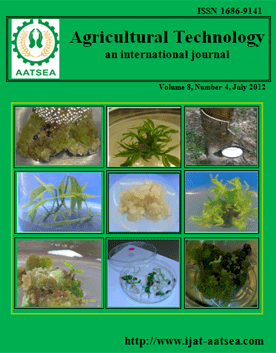ThaiScience
ThaiScience
INTERNATIONAL JOURNAL OF AGRICULTURAL TECHNOLOGY
Volume 14, No. 07, Month DECEMBER, Year 2018, Pages 1949 - 1960
Microbial degradation of musty odor in aquaculture pond
Sompong, U., PongUdom, P. and Whangchai, N.
Abstract Download PDF
Musty odor due to geosmin and 2-methylisoborneol (MIB) is currently the most serious economic problem faced by aquaculture export industry. They are susceptible to biodegradation with many microorganisms responsible for their removal from water. The study reported the potential microorganism which isolated from 10 Tilapia farming in northern Thailand on the degradation of musty odor. Microbial isolation was done using the media containing geosmin and MIB standard solution. Twenty isolates were selected in order to test their efficiencies on degradation of musty odor. After 48 h. of incubation, isolate TS1 was most efficient to reduce geosmin in the media (92.16%) as analyzed by headspace solid phase micro-extraction (HS-SPME) and gas chromatography–mass spectrometry (GC/MS). Whereas, isolate LS6 had optimum efficiency to reduce MIB (76.61%). Five species (Achromobacter denitrificans, Delftia tsuruhatensis, Comamonas sp., Acinetobacter calcoaceticus and Raoultella ornithinolytica) with optimal efficiency to reduce geosmin, and MIB were then in vivo tested for pathogenesis in fishes. It was shown that all the bacterial species did not cause disease in the fish with survival rate of 96.67- 100%. After 48 h. of incubation, Comamonas sp. and Ach. denitrificans had the highest efficiency to reduce geosmin and MIB (about 40% removal). Microbial cultures in the water with subsequent community profile analysis using 16S rRNA-directed PCR-DGGE identified uncultured bacterial species were grown after 48 h. of incubation. Five bacteria most likely involved in the biodegradation of musty odor within the pond water.
Keywords
Geosmin, MIB, Microbial degradation, Musty odor, Off-flavorINTERNATIONAL JOURNAL OF AGRICULTURAL TECHNOLOGY
Published by : Association of Agricultural Technology in Southeast Asia (AATSEA)
Contributions welcome at : http://www.ijat-aatsea.com
